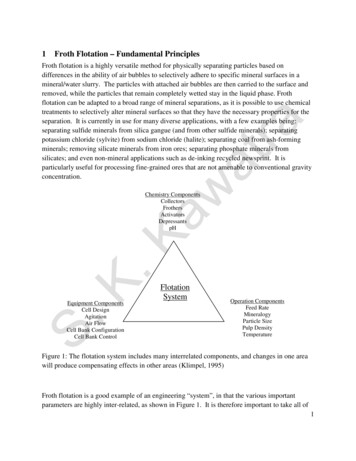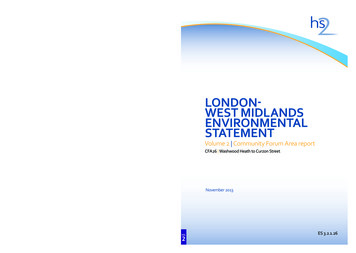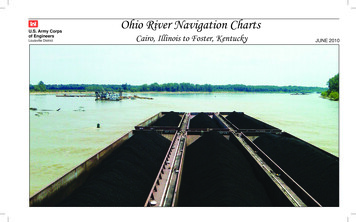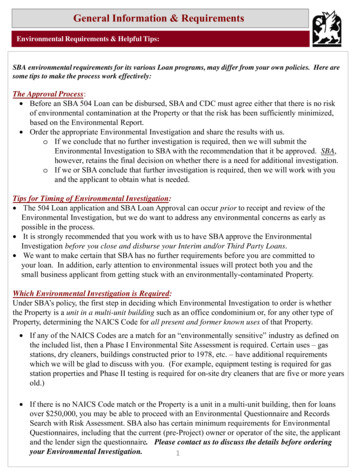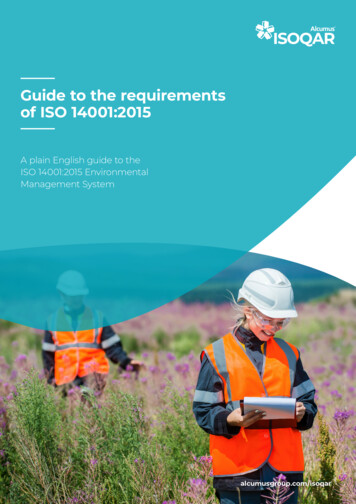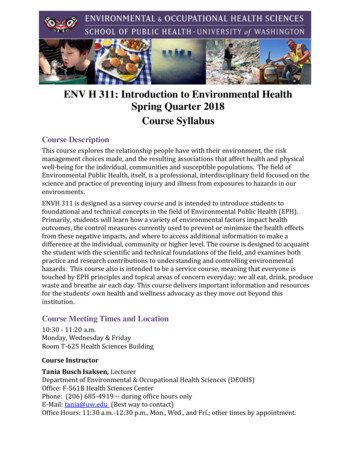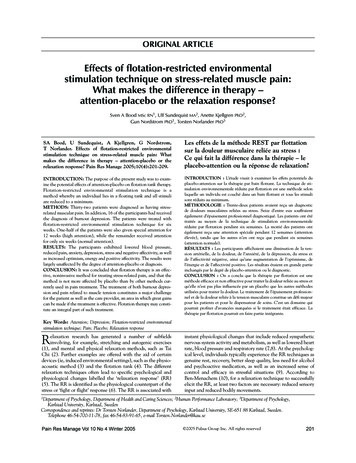
Transcription
Bood.qxd11/18/20053:27 PMPage 201ORIGINAL ARTICLEEffects of flotation-restricted environmentalstimulation technique on stress-related muscle pain:What makes the difference in therapy –attention-placebo or the relaxation response?Sven A Bood MSc RN1, Ulf Sundequist MA2, Anette Kjellgren PhD2,Gun Nordstrom PhD1, Torsten Norlander PhD3SA Bood, U Sundequist, A Kjellgren, G Nordstrom,T Norlander. Effects of flotation-restricted environmentalstimulation technique on stress-related muscle pain: Whatmakes the difference in therapy – attention-placebo or therelaxation response? Pain Res Manage 2005;10(4):201-209.Les effets de la méthode REST par flottationsur la douleur musculaire reliée au stress :Ce qui fait la différence dans la thérapie – leplacebo-attention ou la réponse de relaxation?INTRODUCTION: The purpose of the present study was to examine the potential effects of attention-placebo on flotation tank therapy.Flotation-restricted environmental stimulation technique is amethod whereby an individual lies in a floating tank and all stimuliare reduced to a minimum.METHODS: Thirty-two patients were diagnosed as having stressrelated muscular pain. In addition, 16 of the participants had receivedthe diagnosis of burnout depression. The patients were treated withflotation-restricted environmental stimulation technique for sixweeks. One-half of the patients were also given special attention for12 weeks (high attention), while the remainder received attentionfor only six weeks (normal attention).RESULTS: The participants exhibited lowered blood pressure,reduced pain, anxiety, depression, stress and negative affectivity, as wellas increased optimism, energy and positive affectivity. The results werelargely unaffected by the degree of attention-placebo or diagnosis.CONCLUSION: It was concluded that flotation therapy is an effective, noninvasive method for treating stress-related pain, and that themethod is not more affected by placebo than by other methods currently used in pain treatment. The treatment of both burnout depression and pain related to muscle tension constitutes a major challengefor the patient as well as the care provider, an area in which great gainscan be made if the treatment is effective. Flotation therapy may constitute an integral part of such treatment.INTRODUCTION : L’étude visait à examiner les effets potentiels duplacebo-attention sur la thérapie par bain flottant. La technique de stimulation environnementale réduite par flottation est une méthode selonlaquelle un individu est couché dans un bain flottant et tous les stimulisont réduits au minimum.MÉTHODOLOGIE : Trente-deux patients avaient reçu un diagnosticde douleurs musculaires reliées au stress. Seize d’entre eux souffraientégalement d’épuisement professionnel diagnostiqué. Les patients ont ététraités au moyen de la technique de stimulation environnementaleréduite par flottation pendant six semaines. La moitié des patients ontégalement reçu une attention spéciale pendant 12 semaines (attentionélevée), tandis que les autres n’en ont reçu que pendant six semaines(attention normale).RÉSULTATS : Les participants affichaient une diminution de la tension artérielle, de la douleur, de l’anxiété, de la dépression, du stress etde l’affectivité négative, ainsi qu’une augmentation de l’optimisme, del’énergie et de l’affectivité positive. Les résultats étaient en grande partieinchangés par le degré de placebo-attention ou le diagnostic.CONCLUSION : On a conclu que la thérapie par flottation est uneméthode efficace et non effractive pour traiter la douleur reliée au stress etqu’elle n’est pas plus influencée par un placebo que les autres méthodesutilisées pour traiter la douleur. Le traitement de l’épuisement professionnel et de la douleur reliée à la tension musculaire constitue un défi majeurpour les patients et pour le dispensateur de soins. C’est un domaine quipourrait profiter d’avancées marquées si le traitement était efficace. Lathérapie par flottation pourrait en faire partie intégrante.Key Words: Attention; Depression; Flotation-restricted environmentalstimulation technique; Pain; Placebo; Relaxation responseelaxation research has generated a number of subfieldsinvolving, for example, stretching and autogenic exercises(1), and mental and physical relaxation methods, such as TaiChi (2). Further examples are offered with the aid of certaindevices (ie, induced environmental settings), such as the physioacoustic method (3) and the flotation tank (4). The differentrelaxation techniques often lead to specific psychological andphysiological changes labelled the ‘relaxation response’ (RR)(5). The RR is identified as the physiological counterpart of thestress or ‘fight or flight’ response (6). The RR is associated withRinstant physiological changes that include reduced sympatheticnervous system activity and metabolism, as well as lowered heartrate, blood pressure and respiratory rate (7,8). At the psychological level, individuals typically experience the RR techniques asgenuine rest, recovery, better sleep quality, less need for alcoholand psychoactive medication, as well as an increased sense ofcontrol and efficacy in stressful situations (9). According toBen-Menachem (10), for a relaxation technique to successfullyelicit the RR, at least two factors are necessary: reduced sensoryinput and reduced bodily movements.of Psychology, Department of Health and Caring Sciences; 2Human Performance Laboratory; 3Department of Psychology,Karlstad University, Karlstad, SwedenCorrespondence and reprints: Dr Torsten Norlander, Department of Psychology, Karlstad University, SE-651 88 Karlstad, Sweden.Telephone 46-54-700-11-78, fax 46-54-83-91-65, e-mail Torsten.Norlander@kau.se1DepartmentPain Res Manage Vol 10 No 4 Winter 2005 2005 Pulsus Group Inc. All rights reserved201
Bood.qxd11/14/20053:13 PMPage 202Bood et alIn the present study, a flotation tank was used to induce theRR. Flotation-restricted environmental stimulation technique(REST) is a method whereby an individual lies in a horizontally floating posture, immersed in salt water, in an environment (the flotation tank) in which all stimuli are reduced to aminimum. The salt water in the flotation tank is maintained atskin temperature and earplugs are used to minimize sounds.When the lid of the tank is closed, complete darkness ensues.Flotation-REST is a cost-effective and secure method withminimal or no adverse effects (11,12).Recent research with the flotation form of REST indicatesthat meaningful positive effects may be obtained. Such resultsinclude increased well-being and relaxation (13), mild euphoria (14), greater production of ideas (15,16), increased originality (17,18), improved sleep at night (19,20), reduced stress,tension and anxiety (12,14, 21-23), reduced pain (20,24), fewerheadaches (25), lowered blood pressure (21) and decreasedmuscle tension (26). It also constitutes a suitable complementto psychotherapy (13,27); the method is described as pleasantand subjects eagerly endorse it on later occasions (28).Extensive stress, without the possibility of recovery, frequently leads to both somatic and psychological symptoms(29-32) and burnout depression (33). Burnout depression typically begins with a sense of stress and overload (34).Individuals find it difficult to relax and difficult to fall asleep(35-37); they feel tense, revved up and irritable. Early on, individuals experience aches and pain (38-40). Eventually, theyexperience exhaustion, are unable to feel joy and feel depressed(41); their thinking is circumscribed and one-tracked, andthey find it difficult to be creative. The ability to concentrateand remember things is reduced, and eventually the coursechanges into despair and depression. Initially, the depression ismild but deepens over time (30,42).It is important to systematically chart the effects of variousplacebos, because they have been shown to have an influenceon experimental trials (43,44) and in connection with treatment (45,46). The pain-reducing effects of placebos have beenobtained in several studies (47,48). Given the assumption thatplacebo effects of expectations (49,50) and the importance ofattention (51,52) are inherent in various pain-reducing treatments, it is important to control for these effects, as well asother potential effects such as worrying, anxiety (53), affectivity and optimism (54-58).Given that the expectancy-placebo technique used in alcohol and drug experiments is basically impossible with flotationREST, Norlander et al (28) conducted an experimentincluding two conditions: one with a group of former drugaddicts, who had used hallucinogenic drugs, and a matchedgroup of ‘ordinary’ people; and another with a ‘strict setting’(the experimenter wore a white coat, the walls were barren andthe instructions to lie down in the tank were without comments) and a ‘fantasy setting’ (the experimenter wore a sweatshirt with a suggestive picture on it, there were fantasy pictureson the walls and there was a suggestive depiction of what couldbe expected while lying in the tank). Despite these manipulations, no significant differences were found between the conditions. The conclusion was that what happened in the tank wasnot affected much by either prior experiences or the settingand, consequently, that the flotation-REST technique is mostlikely not sensitive to placebo effects. What happens in flotationREST, as well as in chamber REST (ie, lying on a stretcher in asound- and light-isolated room), though slightly less powerful202(59), appears to be the effect of sensory deprivation, not ofexpectation.Previous studies (20) of pain reduction using flotationREST have not thoroughly addressed the attention-placeboproblem, ie, examined the potential role of attention.However, in a recently completed study by Kjellgren et al (20),in which the participants in the control group and the flotation group received equal amounts of attention, the results suggested that attention-placebo is not a factor of importance interms of the flotation-REST results. To further examine thisissue, the patients of the present study were treated with flotation-REST for a period of six weeks, and attention was given intwo conditions: for six weeks in conjunction with the tank visits, or for 12 weeks, including six weeks before the treatmentand for six weeks in conjunction with the tank visits.Patients with stress-related pain often, over time, developproblems that are diagnosed as burnout depression (29,33). Inthe present study, we explored whether there are differencesbetween patients with or without burnout diagnoses withregard to attention.To examine the potential effect of attention-placebo inpain treatment, it is important to find different ways of measuring perceived pain (20), because it could be that intense painis affected by a particular treatment, whereas low-intensitypain is not. The more consistent the responses of the participants in terms of different measures of pain following treatment, the more reliable the measures in terms of assessing thepatients’ total pain experiences. Previous studies (20), in largepart, only focused on the intensity of the pain. In the presentstudy, several different aspects of pain assessment were used(eg, the breadth of the area of pain, the number of areas of painand the different types of pain), with the purpose of providinga more all-encompassing picture of patients’ pain problems,and how they are affected by attention as well as flotationREST.METHODSParticipantsThirty-two patients (25 women and seven men) were recruitedfrom the waiting list at the Human Performance Laboratory atKarlstad University, Karlstad, Sweden. They had been diagnosedby a physician as having stress-related pain of a muscle tensiontype. They reported having had such pain for an average of11.37 9.92 years and 21.9% stated that they experienced the painduring the day and night, 43.8% daily, 25% weekly, 6% monthlyand 3.1% rarely. Among the patients, 16 of them had also receivedthe diagnosis of burnout depression (including symptoms such asfatigue, less energy, problems with organizing daily life, problemswith memory and processing new information, problems withsleep and feelings of low spiritedness, with the ailments not beingrelieved by rest). One-half of the 32 patients received specialattention (see Design and Procedure) for a total of 12 weeks (highattention), while the other half received attention for only sixweeks (normal attention). The average age of the patients was48.46 9.51 years. Statistical analyses using independent samplet tests (5% level) yielded no significant age differences betweengroups regarding sex, burnout depression or attention (P 0.05).DesignThe study used a three-way split plot design in which treatment withthe flotation tank, with assessments before and after the tank visit,constituted the within-subjects factor, and attention (ie, normalPain Res Manage Vol 10 No 4 Winter 2005
Bood.qxd11/14/20053:13 PMPage 203Attention-placebo or the relaxation response?attention or high attention) and diagnosis (ie, nonburnoutpatients with stress-related pain or burnout patients with stressrelated pain) constituted the between-subjects factors. The variable attention was created by giving one-half of the patientsattention for 12 weeks and the other half for only six weeks (seeProcedure). The group with normal attention was comprised ofnine patients without burnout depression and seven patients withdepression, whereas the group with high attention was comprisedof seven patients without burnout and nine patients with burnoutdepression. There were significantly more women than men, butthey turned out to be quite evenly distributed across conditions,attention (three and four patients) and diagnosis (five and twopatients). All participants, regardless of condition, were treatedwith flotation-REST for a seven-week period. The period consistedof two treatments per week for three weeks, followed by a weekwithout treatment, then another three weeks of treatments. Thus,the participants received a total of 12 flotations during two periodsof three weeks each.MeasuresFlotation tank: A flotation tank (Delfi, Varberg, Sweden) measuring 2700 mm 1500 mm 1300 mm was used. The depth of fluid(salt water) varied between 200 mm and 300 mm. The flotationtank was insulated to maintain a constant air and water temperature and to reduce incoming light and noise. The water temperature was maintained at 34.7 C and was saturated with magnesiumsulphate (density 1.3 g/cm3). The tank was equipped with a horizontal entrance that was easy to open and close (from both theinside and the outside) by the subject. Between flotations, ahydrogen peroxide solution was poured in; then, the salt water wasfiltered and sterilized with ultraviolet light. The number and duration of treatments, ie, 12 treatments over a seven-week period(two three-week treatment periods with a nontreatment week inbetween), was based on similar procedures described in the literature and from the authors’ experiences. The reason for having twothree-week treatment periods was so that participating womencould plan the timing of their flotation treatments from the incidence of each menstrual cycle.Questionnaire 1: Before the treatment (ie, attention and floating),a questionnaire was provided that estimated each subject’s selfassessed pain: intensity, areas and types, frequency, duration, onsetand treatment, as well as experience or symptoms of other types ofcomplaints. Each subject’s own descriptions of ‘most severe painintensity’ and ‘normal pain intensity’, respectively, were estimatedon visual analogue scales (0 to 100). Additionally, informationregarding alcohol consumption was collected.Questionnaire 2: At a final meeting, after seven weeks of theexperimental flotation procedure, the same questions were presented as in questionnaire 1.Pain area inventory: The pain area inventory (PAI), developedfor use in the present study, consisted of two anatomical images ofa human being, one frontal and one dorsal. The task of the participants was to indicate with a colour pen their areas of pain andcolour them in. A transparent, plastic film was then placed overthe coloured areas on both figures. Each figure was divided into833 equal-sized squares (1666 total), and the number of colouredsquares was calculated. The size of the square was 3 mm 4 mm,and one square (12 mm2) corresponded with 0.06% of the totalarea of the two figures.A correlation, computed with the aid of an interitem analysis,included all measures of pain (ie, PAI, the total number of paintypes, the number of connected pain areas, most severe painPain Res Manage Vol 10 No 4 Winter 2005intensity, normal pain intensity and pain frequency) followingtreatment, indicated a high degree of consistency of the responses(standardized item alpha 0.84). A multiple regression (entermethod) with PAI (ie, number of squares) as the criterion variableand the other pain measures as predictor variables yielded a significant correlation (r 0.70, P 0.001). Test-retest reliability wasexamined using a group of pain patients (n 34) who completedthe PAI on two occasions, seven weeks apart (r 0.92, P 0.01).Stress and energy: The stress and energy (SE) instrument was aself-estimation instrument concerning individuals’ energy andstress experiences (60). It consisted of two subscales that elucidatedthe mood levels of the subjects on the dimensions ‘experiencedstress’ and ‘experienced energy’. The response alternatives werearranged on six-grade scales, extending from 0 (not at all) to 5(very much). The instrument has been validated by analyses fromstudies (60-62) focused on occupational burdens and pressures.The SE scale was constructed and based on an early and much usedchecklist, the Mood Adjective Checklist, constructed by Nowlisand Green (63), and modified further and translated into Swedishby Kjellberg and Bohlin (62). Kjellberg and Iwanowski (60) reducedthe list to 12 adjectives in two dimensions. It is the most currentversion of the SE scale (with test-retest scores of 0.73 to 0.78) andwas used in the present study. The test did not have a time limit.Hospital anxiety depression scale: The hospital anxiety depression scale (HAD) scale is a rating scale used to measure the degreeof anxiety and depression, and is referred to in various publishedarticles. It was constructed by Zigmond and Snaith (64) for usewith physically ill people. It has since been revised to be used as arating scale for anxiety and depression. Its validity and reliabilitywere examined by Hermann (65). The instrument consists of14 statements with four response alternatives (ie, 0 through 3),ranging from positive to negative or vice versa, with seven statements regarding anxiety and seven regarding depression.Life orientation test: The life orientation test (LOT) (66) consists of eight items plus four filler items. The task of each participant is to decide whether one is in agreement with each of theitems described on a scale of 0 to 4, where 0 indicates ‘strongly disagree’ and 4 indicates ‘strongly agree’. The test measures dispositional optimism, defined in terms of generalized outcomeexpectancies. Parallel test reliability is reported at 0.76 and internalconsistency at 0.76 (66) and test-retest reliability is reported at 0.75(67). LOT is also regarded as having an adequate level of convergent and discriminant validity (66), as demonstrated by correlationstatistics and by using LISREL VI (SPSS, USA) (r 0.64).Positive affect and negative affect scales: The positive affect andnegative affect scales (PANAS) instrument (68-71) assesses thedegree of affect, both negative affect (NA) and positive affect(PA). The instrument consists of 10 adjectives for the NA dimension and 10 adjectives for the PA dimension. In the test manual(71), it is postulated that the adjectives describe feelings andmood. The participants were asked to estimate how they had beenfeeling during the last week. Response alternatives are presentedon five degree scales ranging from 0 (not at all) to 5 (very much).The PANAS scale has been validated through studies focused onseveral different routinely used scales within psychopathology(72). Cronbach’s alpha for PA was 0.73 and for NA was 0.76 inthe present study.ProcedureThe participants were recruited from the waiting list for participation in the flotation-REST experiment at the Human PerformanceLaboratory, Karlstad University. They were originally referred by203
Bood.qxd11/14/20053:13 PMPage 204Bood et altheir physicians or had responded to announcements for individuals suffering from localized muscle tension pain in the neck andshoulder area, with or without temporal headache, associated withmyofascial tender points or trigger points. At the same time,patients were recruited from the list to two experiments: a firstexperiment with 70 participants; and a second experiment (thepresent study) with a flotation-REST group consisting of 16 individuals. The two experiments overlapped.For the present study, the high attention group was recruited byasking 20 patients, who had just completed participation in thecontrol group (in the first experiment), whether they would bewilling to continue immediately with a new experiment involvingthe flotation tank. This means that they were not asked at thesame time but rather when their participation in the control groupwas to finish. They had not been told before the first experimentthat they would have the option of receiving flotation therapyafter the control sessions had ended. Asking 20 individuals seemedreasonable because estimates on power, based on earlier experiences, indicated that 15 individuals in each group would be sufficient to detect a treatment effect. All of the patients agreed toparticipate in a new experiment, but four of them cancelled due tolack of time immediately before the experiment or in the beginning of treatment. Thus, the group consisted of 16 participants.Given that they had already participated in a control group, theyhad regularly visited the laboratory and met the staff to the sameextent as the flotation group (normal attention). On those occasions, they sat alone in a closed room, in an easy chair readingtheir own literature or literature provided for 45 min twice perweek for three weeks; they then had one week with no treatment,followed by another three weeks with attention. In the new experiment, the participants immediately continued with the flotationREST treatment and with identical treatment intervals (ie, twicea week for three weeks, then one week without treatment, followed by a final three-week period), along with continued visitswith the staff as before. The nature of attention (ie, associatingwith the staff) the group received was the same across the first andsecond set of 12 sessions, even though the activity alone in aclosed room (ie, armchair- or flotation-REST) differed. Thus, thisgroup received flotation treatment 12 times and attention on24 occasions during a period of 12 weeks.The other group (normal attention) had not had any previouscontact with the laboratory but was randomly recruited straightfrom the patient waiting list as described. The procedure was complete when 16 people agreed to participate in the experiment andfulfilled the criteria for inclusion. Subsequently, two individualsdropped out, one for lack of time and the other due to his experience of being shut in the tank at the beginning of the flotationREST treatment. They were then replaced by two individualsrandomly picked from the waiting list. All in all, this group alsoreceived 12 treatments during a period of six weeks, but attentiononly at the time of their 12 tank visits.With regard to the second independent variable of the study,experience was already available, suggesting that approximatelyone-half of the patients with stress-related pain from musculartension who seek treatment are also diagnosed with burnoutdepression. Thus, no further groupings of patients were carriedout. Only in connection with the analyses was it found that thenormal attention group consisted of seven patients with the diagnosis of burnout depression, whereas the groups with high attention consisted of nine patients with that diagnosis. These numberswere deemed sufficient for the statistical requirements of a threeway ANOVA with mixed design.204Both the high and normal attention group had to visit the laboratory physician and a pain specialist before the study, where theywere informed about the project, screened for suitability throughquestionnaire 1, underwent a medical examination (which includedblood pressure and heart rate) and a careful pain analysis, including palpation of muscle tone and a neurological examination.Among the exclusion criteria were pregnancy or breastfeeding,somatic problems or illnesses requiring other types of treatment,open wounds, manifest psychiatric symptoms, neurological disturbances, whiplash related disorders, manifest post-traumatic stressdisorder, as well as regular treatment with heavy opiate analgesicsand signs of anxiety/fear or discomfort being in a restricted environment.During the interview, each participant’s degree of anxietydepression was assessed using the HAD scale, whereupon the otherpersonality tests and other psychological tests were completed.Every participant received a leaflet with patient-oriented information about flotation-REST, wherein (in addition to the purelypractical details associated with treatment) they were alsoinformed that driving was not recommended shortly after treatment (due to increased risk of transient tiredness). During this initial contact, each subject was shown around the floatarium. Theinformation was restricted (no mentioning of possible changes inconsciousness), and the participants were only informed that mostpeople experience the floating as relaxing.All participants were given flotation treatment during theforthcoming three periods (with two visits per week); each floating session was 45 min in duration. After that, the participantshad one week without treatment, followed by another three-weekperiod of treatment. The experimenters at the flotation site wereignorant of the group identity of each participant and, thus, for allpurposes, experimentally blind. A procedure consisting of a ‘firstcome, first assigned’ method was applied. When the participantwas using the flotation tank at the very first session, the patientwas informed of the flotation technique, shown the bathroom andshower, and thoroughly reminded of their freedom to terminatethe session if necessary. Following instructions to visit the bathroom, shower, insert earplugs and relax, each participant wasallowed to immerse in the water of the tank and close the lidunaided. Treatment was terminated after 45 min, when the experimenter gently knocked on the exterior of the tank. Three days (or72 h) after the final treatment session, participants attended afinal consultation and follow-up discussion, at which time theycompleted questionnaire 2 and the psychological tests. All of thepatients described completed the whole course of treatment (ie, 12sessions over six weeks).RESULTSPain measurementsStatistical analyses were carried out using three-way split plotANOVA with treatment as the within-subjects factor andattention and diagnosis as between-subjects factors, and withthe number of different ways of measuring subjective pain (ie,PAI, number of different types of pain, number of comprehensive pain areas, most severe pain intensity, normal pain intensity and pain frequency) as the dependent variables. For meansand SDs, see Table 1.PAIThe analyses yielded a significant difference for treatment(F[1,28] 18.42, P 0.001, Eta2 0.40, power 0.99), and aPain Res Manage Vol 10 No 4 Winter 2005
Bood.qxd11/14/20053:13 PMPage 205Attention-placebo or the relaxation response?TABLE 1Pain measurement scores before (1) and after (2) treatment in regard to attention and diagnosisNormal attentionHigh dDepressedBefore and afterPAI 184.78 (83.36)224.14 (196.23)126.14 (93.86)188.79 (185.00)153.56 (151.03)PAI 236.22 (25.79)88.86 (113.90)50.86 (62.16)30.22 (41.08)49.25 (65.94)*Types† 13.33 (1.41)2.71 (0.49)2.43 (1.13)2.89 (1.62)2.88 (1.26)Types 22.33 (1.22)1.71 (1.25)1.86 (1.07)1.56 (1.33)1.88 (1.21)*Areas‡ 16.33 (2.65)10.14 (11.78)4.14 (3.02)5.78 (3.67)6.53 (6.19)Areas 24.11 (3.10)7.29 (10.70)2.57 (2.15)2.00 (3.20)3.88 (5.68)*73.11 (21.35)62.71 (27.24)65.43 (21.68)75.11 (28.43)69.72 (24.24)52.72 (26.09)*Severest§ 1Severest 270.33 (14.85)**48.29 (26.46)33.29 (23.73)**53.67 (27.77)Normal¶ 141.33 (16.93)37.86 (23.25)44.71 (13.11)33.00 (22.11)38.97 (18.91)Normal 237.33 (14.75)28.71 (20.96)16.57 (19.34)25.00 (26.05)27.44 (21.12)*Frequency†† 14.11 (0.60)3.71 (0.76)4.29 (0.76)3.00 (1.22)3.75 (0.98)Frequency 23.89 (0.78)3.14 (1.46)2.86 (1.68)2.78 (1.48)3.19 (1.38)*Data are presented as mean (SD). *Significant difference (P 0.05) in the after condition; **Significant difference for attention by diagnosis (P 0.05) in the nondepressed and after conditions; †Number of different types of pain; ‡Number of comprehensive pain areas; §Severest pain intensity; ¶Normal pain intensity; ††Pain frequency. PAI Pain area inventorydescriptive analysis showed that pain assessed with the PAIwas reduced from 153.56 squares (SD 151.03 squares) to49.25 squares (SD 65.94 squares) during the period of treatment. There were no other significant effects (P 0.05).Number of different types of pain: The analyses yielded a significant difference for treatment (F[1,28] 16.25, P 0.001,Eta2 0.37, power 0.97), and a descriptive analysis showedthat the number of types of pain was reduced from 2.88(SD 1.26) to 1.88 (SD 1.21) during the treatment period.There were no other significant effects (P 0.05). Additionalanalyses suggested that headaches, jaw, neck and, in particular,bac
placebo effects of expectations (49,50) and the importance of attention (51,52) are inherent in various pain-reducing treat-ments, it is important to control for these effects, as well as other potential effects such as worrying, anxiety (53), affectiv-ity and optimism (54-58). Given that the expectancy-placebo technique used in alco-
